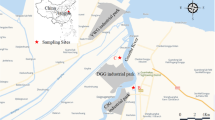Abstract
The aim of this study was estimation of PCDD/PCDFs emissions from various sources in Iran. The results indicated total PCDD/PCDFs emissions in Iran in 2010, was 1,957 g TEQ. Of this amount, about 705.8, 0.5, 463.5, 144.1 and 643.2 g TEQ/year was released to air, water, land, products, and in residues, respectively. Open burning processes and metal production are the major contributors to be known environmental sources of PCDD/PCDFs that contribute to about 70% of total PCDD/PCDFs emissions in Iran. The results showed that total PCDD/PCDFs emissions in Iran per inhabitant were about 26.5 g TEQ/million that is high relatively.



Similar content being viewed by others
References
Ba T, Zheng MH, Zhang B, Liu WB, Xiao K, Zhang LF (2009) Estimation and characterization of PCDD/Fs and dioxin-like PCBs from secondary copper and aluminum metallurgies in China. Chemosphere 75:1173–1178
UNEP Chemicals (2005) Standardized toolkit for identification and quantification of dioxin and furan releases, 2 ed. UNEP Chemicals, Geneva. Available via. http://www.pops.int/documents/guidance/toolkit/en/Toolkit_2005_En.pdf. Accessed Feb 2005
Cheng H, Hub Y (2010) Curbing dioxin emissions from municipal solid waste incineration in China: re-thinking about management policies and practices. Environ Pollut 158:2809–2814
Dyke P, Coleman P, James R (1997) Dioxins in ambient air, bonfire night 1994. Chemosphere 34:1191–1201
Kulkarni PS, Crespo JG, Afonso CAM (2008) Dioxins sources and current remediation technologies—a review. Environ Int 34:139–153
Llobet JM, Domingo JL, Bocio A, Casas C (2003) Human exposure to dioxins through the diet in Catalonia, Spain: carcinogenic and non-carcinogenic risk. Chemosphere 50:1193–1200
Pulles T, Kok H, Pesik J (2004) Dioxin emissions in the Haifa region, TNO Report No. R 2004/016, TNO Apeldoorn. Available via. http://www.envihaifa.org.il/heb/dioxins012004.pdf. Accessed May 2004
Wu YL, Lin LF, Hsieh LT, Lin C, Chang-Chien GP (2009) Atmospheric dry deposition of polychlorinated dibenzo-p-dioxins and dibenzofurans in the vicinity of municipal solid waste incinerators. J Hazard Mater 162:521–529
Zhang B, Meng F, Shi C, Yang F, Wen D, Aronsson J, Gbor PK, Sloan JJ (2009) Modeling the atmospheric transport and deposition of polychlorinated dibenzo-p-dioxins and dibenzofurans in North America. Atmos Environ 43:2204–2212
Author information
Authors and Affiliations
Corresponding author
Rights and permissions
About this article
Cite this article
Momeniha, F., Nabizadeh, R., Hassanvand, M.S. et al. Emissions of Polychlorinated Dibenzo-p-Dioxins and Dibenzofurans (PCDD/PCDFs) in Iran. Bull Environ Contam Toxicol 87, 708–712 (2011). https://doi.org/10.1007/s00128-011-0392-y
Received:
Accepted:
Published:
Issue Date:
DOI: https://doi.org/10.1007/s00128-011-0392-y




